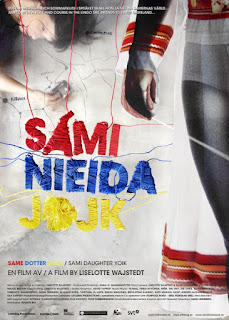by Jessica Malmberg and James Buckland
Early in the morning we pile in the car and drive from Dundret to Jokkmokk, just a half hour south. A few minutes in, the car comes to a screeching halt - four or five reindeer are on the road, trotting nervously back and forth, coats molting and hooves clattering on the thin concrete stretch of road.
Reindeer are free-roaming - they are herded, loosely, by region, but they are not fenced in - and these were free-roaming down the road. Our tour guide at the Laponia Naturum yesterday mentioned that they are sometimes hit by cars and then not reported. Instead, we sit and wait for them to cross the road. Then we drive on, a little slower and a little more aware.
Close to Jokkmokk, we drove over a bridge, crossing Lule river, and suddenly we see colorful paintings. There is a small dam sitting across the river, but the roar of the waters is nothing compared to the brilliant paintings done across their floodgates. In the 1970s, when the dam was constructed, local Sami artists designed their facades - bold red and yellow swathes with symbols and glyphs strewn across them. It is beautiful and very, very strange. The control building above the dam has is colored, as are the concrete buttresses holding up the wall. It doesn’t look like art, but it doesn’t look like a dam either. I think it’s quite beautiful. There is a bitter story behind the dam and the artwork, though. When the plan of the dam was presented, the people of Jokkmokk and especially the Sami people started protesting, since the dam would have a big impact on the Sami village and the surrounding Jokkmokk area.
In Jokkmokk we went to the Sami cultural museum, Ájtte. It is a phenomenally well-designed and engaging museum, with beautiful art and artifacts, reconstructions and reproductions, informative text and interactive exhibits alike. Our tour guide, a very patient young Sami woman, takes us through some of the main exhibits and talks with us at length about the history of the Sami people - their daily life, their customs and costumes, and the reindeer-husbandry lifestyle. A large portion of the museum follows reindeer husbandry across a yearly cycle, tracking eight seasons for eight stages of the animal’s reproductive cycle. As the reindeer move across Norrbotten, so do the individual Sami families who own them - as they have done for hundreds of years. It is a very beautiful and very engaging museum - we could have spent eight hours there and not seen it all, it was so much.
After having lunch outside the museum we head back north towards Porjus where we are going to have a guide tour in the old hydropower station. Porjus is the first great hydropower station build in Sweden in 1910. It was mainly built to provide the mines and the communities around the mines with electrical power. Porjus is today the 4th greatest hydropower dam in the Lule river, producing 480 MW/year. When arriving in Porjus we are met by a big brick building and a quite big powerplant. Today is the dam’s machinery room underground in the rock so you can’t see so much of the hydropower dam. Just the empty river and the earth dam.
Coming into the reception we are greeted by our guide, Ida. She shows us around the old building, which was the station house at the time of the opening of the hydropower plant. We get to see the old control room with lots of buttons and sticks. In the center of the room is a table placed with two really old telephones, which was how the staff was communicating during the beginning of 1900. Thereafter we took the elevator down 50 meters underground to see the first turbine and generator that was built 1910, at that time only producing 17 MW/year.
At the reception we see that the two Sami girls that we had as guides at Naturrum the day before also guides at Porjus hydropower plant. We would think that Sami people that is reindeer herders wouldn’t want to work part time at a place that have affected their environment tremendously. But this shows the complicated relation between the Sami people and the industrialisation of the Norrbotten area.
After the visit at Porjus we went back to Dundret, Gällivare, to start packing our things for the travel back to Stockholm the next day.
The course came to an end at the 4th of July. We have seen so much, visited various places and driven to many places in rain, walked up the mountains surrounding Tarfala in the midnights sun. But it was time to go south. In the morning we packed our things and had a final discussion regarding the course. Thereafter we headed back towards Kiruna, to fly back to Stockholm. We have learned so much, had so many interesting discussions thanks to everyone who was a part of this course!






















































